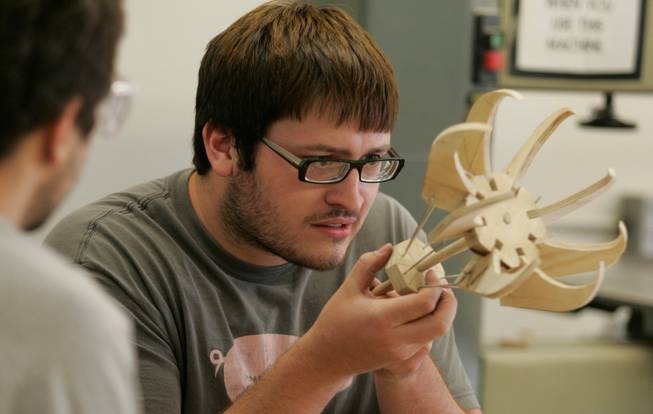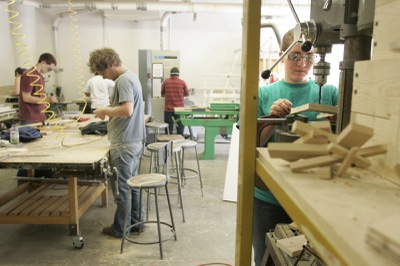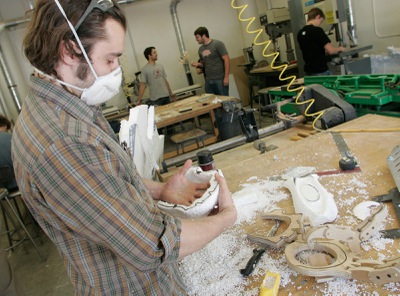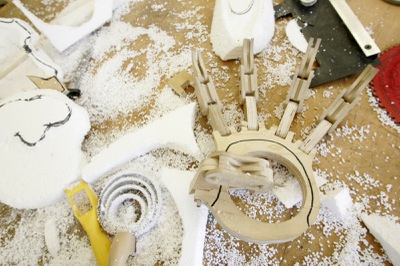
Jordan Mayorga checks his work April 9 on a claw he designed during a class that is part of UNLV’s Entertainment Engineering and Design program.
Sunday, April 20, 2008 | 2 a.m.
You’ve scored tickets to a big show on the Las Vegas Strip. A Cirque du Soleil show, say. Or “Phantom of the Opera.” And something happens up there onstage.
A body sinks slowly to the bottom of the sea, trailing a swirl of iridescent bubbles as it descends. An enormous stage slowly tilts 90 degrees on its axis, spilling what had been a sandy beach over the abyss like an amber waterfall. A glittering chandelier plummets from the ceiling, halting mere feet above your head.
And you sit there stunned, wondering: How did they do that?
Someone has to figure out the technological trickery that creates the sort of staggering stage magic for which Vegas is famous. And UNLV is taking the lead, inaugurating a multidisciplinary program merging engineering technical expertise with the creative instincts of the fine arts — with the priceless advantage of access to the largest laboratory in the world, the Las Vegas Strip.
It doesn’t look like a haunt of academic types, but this cluttered, clamorous garage on the UNLV campus is an incubator for the next generation of inventors and problem solvers. The students enrolled in the prototype for the university’s Entertainment Engineering and Design bachelor’s degree program are the next generation of professionals skilled in cutting-edge entertainment production. Entertainment industry partners include such giants as Cirque, Fisher Technical (which developed technologies for “Le Reve” and “Ka”), Stage Technologies and the venerable Flying By Foy for classroom lectures, backstage tours and internships.
“Cirque du Soleil, for instance, needs people who understand theater and who understand engineering principles to come into their showrooms, so they can design, build, install and maintain the increasingly complex systems that they’re using,” says associate professor Joe Aldridge, coordinator of UNLV’s College of Fine Arts. “They’ve got a stake in this. They hope to see this grow into something where they can hire students to join them.”
“By the end of their sophomore year, ideally, they’ll be what the entertainment industry is looking for,” says assistant professor Daniel Cook from the department of mechanical engineering, who designed the curriculum with Aldridge.
So in the near future, when a sky’s-the-limit creative dreamer such as Franco Dragone wants to create a jaw-dropping underwater or extraterrestrial effect for his latest spectacular, these are the kids who will figure out how to make it work. And they’ll have a foot in the constantly revolving door of the entertainment industry.
Vegas is watching. So is Disney. And Broadway. And the world.
• • •
“Engineering, in its many manifestations, has always been a part of live entertainment,” says Aldridge, who has decades of hands-on technical experience with Las Vegas shows. “Today’s entertainment industry has to be superconscious of health and safety issues, cost issues, efficiency of operation of mechanical, electrical, hydraulic, pneumatic machinery systems and maintenance issues. All of which are handled through the proper design and engineering of these systems.”
Since the end of World War II, mechanical, electrical, civil engineering and computer science have played an increasing role in entertainment, Aldridge says. Since the 1960s, with the advent of theme parks, the demand for bigger, better and more technologically complex forms of entertainment has grown. People in the industry began to compete for entertainment dollars with one another and with movies, TV and eventually computer and video games. To be competitive, show producers had to outdo their competitors in hopes of enticing the public (and its dollars) to their venues.
“When I moved to Las Vegas, entertainment in the casinos was not expected to turn a profit — it just needed to draw customers to the casino and keep them there to spend their money,” Aldridge says. “Until the original MGM Grand Hotel was built, the smaller hotels were able to compete rather inexpensively. The technology was growing at a slower pace, and the production shows were similar in size and scope. They were less expensive to mount. When the Ziegfeld showroom opened in 1973, it was on a par with the Metropolitan Opera House in the Lincoln Center for the Performing Arts. Its stage was as well-equipped as any in the country. Since then, any showroom built in Las Vegas has utilized and developed technology that surpassed the previous theaters’. One of the first theaters in town built specifically for a production was designed and built for Siegfried & Roy’s production show at the Mirage. The rest is history.”
That history has recently been marked by a “top that!” approach to stage spectacle. The aquatic “O” and “Le Reve” led to the shifting stages of “Ka,” to the widescreen projections of Celine Dion’s “A New Day,” and so on.
What are they going to blow our minds with next?
• • •
As entertainment production companies in Las Vegas and elsewhere push the limits of technology, they drive the need for new ideas and competent professionals. In this fast-growing field, designers need a solid foundation in engineering fundamentals and the knowledge of how to incorporate these fundamentals into an artistic environment.
That’s where the new curriculum comes in, and just in time. Combining faculty expertise and support from UNLV’s College of Fine Arts and the Howard R. Hughes College of Engineering, the program is designed to immerse students in a unique combination of engineering principles, material design, emerging technologies and theatrical production techniques. The curriculum has been endorsed by working professionals and hiring managers throughout the Las Vegas entertainment industry, giving UNLV students an inside track when preparing for careers. UNLV has been recruiting tech-savvy candidates from among high school and college students locally and throughout the nation — 20 to 25 are expected to be enrolled for the first official semester in September.
Local industry leaders say graduates with this kind of expertise are in high demand.
“In the United States, I estimate that there are currently openings for 200 to 300 qualified engineers,” says John T. Rodgers of V-J Ltd., which designs, fabricates and installs fire effects, pyrotechnics, steam fog and other special effects for casinos and theme parks. “Worldwide, I estimate the need to be two to three times as great. One of the major exports of the United States the past few decades is in entertainment-based products. This marketplace could be maintained and expanded if qualified engineers were available to support the needs of the customer.”
Experimental courses in engineering design have been offered at UNLV since spring 2003, each averaging more than 20 students. UNLV hosted a “Conversation on Entertainment Engineering” in 2005, during which industry CEOs, manufacturers, retailers and installers gathered to share ideas and opportunities regarding the proposed program.
“We’re not going into film, we’re not going into television,” Aldridge says. “There are other schools that do that and do it very well. We’re not going into game design; there are other schools that have a leg up on us and we couldn’t begin to compete with them. What we have that they don’t have is the Strip. We have access to technology that’s being developed here and exported to other parts of the world.”
• • •
The classroom is a literal junkyard, cluttered with sharp edges and messy with unknown goop and residues just waiting to permanently stain, if not dissolve, a visitor’s dry-clean-only sport coat.
The constant noise is overwhelming, a teeth-gritting wall of sound. With all the whirs and whines, low-pitched rumbles and grinding, it sounds like the Dentists of the Gods are at work.
A mix of arts and engineering students works on individual projects, intently applying the force of power hand drills and table saws to plywood and Styrofoam. They’re watched over by Aldridge and Cook, who says they are “the brain trust” of the program.
“T-R-U-S-S,” says Aldridge.
That’s an engineering joke.
Near a sculpture made of Coke cans and a makeshift guillotine that bears the warning “Do not steal wood. If it has a name on it, it is not free,” mechanical engineering student Jordan Mayorga checks his work on an elegant if somewhat sinister claw mechanism. Mayorga and his classmates are working out their own designs for a wooden kinetic structure, a device capable of picking up a ball 2 inches in diameter and depositing it into a cup.
“I love this class — it’s awesome,” says Mayorga, a fan of Rube Goldberg machines. “We get tons of experience; it’s tons of fun designing and building something and seeing how it works. A lot of time in our classes we do a lot of designing and testing a design mathematically. But it’s a pretty rare occasion when we get to build something. This is all about taking the artist’s vision and being able to apply it in the real world.”
“These students are going to be able to build the infrastructure for all the new shows that Cirque is putting up,” Cook says, his voice competing in vain with a dissonant chorus of power tools. “We’re not making sound engineers and lighting engineers who sit there and twiddle knobs. They’re going be the ones who invent that new technology.”
Says Aldridge, speaking for himself and his students to come, “There’s more glory in what we do than in appearing in front of an audience.”




Join the Discussion:
Check this out for a full explanation of our conversion to the LiveFyre commenting system and instructions on how to sign up for an account.
Full comments policy